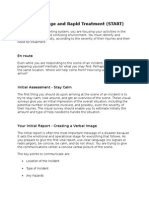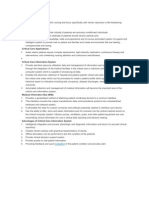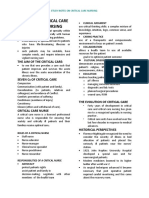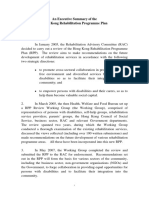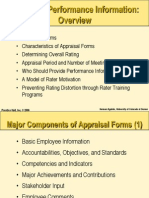Emergency Nursing
Emergency Nursing
Uploaded by
Jamaica WineCopyright:
Available Formats
Emergency Nursing
Emergency Nursing
Uploaded by
Jamaica WineCopyright
Available Formats
Share this document
Did you find this document useful?
Is this content inappropriate?
Copyright:
Available Formats
Emergency Nursing
Emergency Nursing
Uploaded by
Jamaica WineCopyright:
Available Formats
EMERGENCY NURSING
GENERAL INFORMATION 1. What is "Emergency Nursing?" Emergency Nursing is a specialty in which nurses care for patients in the emergency or critical phase of their illness or injury and are adept at discerning life-threatening problems, prioritizing the urgency of care, rapidly and effectively carrying out resuscitative measures and other treatment, acting with a high degree of autonomy and ability to initiate needed measures without outside direction, educating the patient and his family with the information and emotional support needed to preserve themselves as they cope with a new reality. These activities may be carried out in a variety of settings and not necessarily in an "Emergency Room." 2. Don't all nurses take care of patients in emergencies? Yes, within their own specialty, nurses should be prepared to take care of foreseeable emergencies. However,Emergency Nurses, are a specialty that spans all others focusing on the time and criticality aspects, as the nurse who first cares for the sudden emergency must be as capable of caring for cancer patients as trauma patients, and of providing "ambulatory care" for lesser or outpatient problems, which have caused a temporary crisis or need for urgent medical care. 3. Isn't "Emergency Nursing" the same as "Trauma Nursing"? Emergency Nursing comprises all aspects of initial critical care whether applied to trauma-originating problems or those of medical or surgical origin or in the treatment of other specialties such as mental health. In those settings, where there is high focus or numbers of trauma patients, that designation has often been found but reflects a sub-specialty narrowing of view or clientele. 4. How is "Emergency Nursing" different from other nursing? An Emergency Nurse is characterized by high degrees of knowledge and skills, with diagnostic and decision-making power to effectuate urgently needed activities in autonomous fashion or in the closely-collaborative team approach with other health professionals Typically, an Emergency Nurse is capable of providing a broad spectrum of skills that in other settings would be delegated to other health care workers. Without disregarding the critical activities, Emergency Nurses commonly triage and treat less urgent problems, providing care and treatment of those injuries or illnesses, and providing the educational and psychosocial evaluations and support to return the patient successfully to his milieu. 6. What is the preparation and training of an Emergency Nurse? Emergency Nursing has drawn nurses from many backgrounds and specialties, and the rich eclecticism this brings gives vitality and useful support for colleagues. Often, there has been a strong medical-surgical, critical-care, or cardiac background, however, with good support new graduates have succeeded in Emergency Nursing. The focus is on broad clinical knowledge, excellent skills, flexible and adaptable approach, and strong inter-personal and teaching ability. Certification courses in adult and child advanced life support, and core-curricula in Emergency Nursing and in Trauma are useful. A good Emergency Nurse continues education and training throughout the career. 7. Is there a professional organization for Emergency Nursing? In the United States of America, the professional organization of the specialty is the Emergency Nurses Association. There are other organizations in other countries. Historical Development of Emergency Nursing Florence Nightingale was the first emergency nurse, providing care to the wounded in the Crimean War in 1854 The Emergency Department Nurses Association (EDNA) was organized in 1970 A competency-based examination, first administered in 1980, provides Certification in Emergency Nursing; certification is valid for 4 years EDNA developed Standards of Emergency Nursing Practice, published in 1983, to be used as a guideline for excellence and outcome criteria against which performance is measured and evaluated 5. In 1985, the Association name was changed to Emergency Nurses Association (ENA), recognizing the practice of emergency nursing as rolespecific rather than site-specific. SCOPE AND PRACTICE OF EMERGENCY NURSING An emergency nurse has had specialized education, training, experience, and expertise in assessing and identifying patients health care problems in crisis situation. An emergency nurse establishes priorities, monitors and continuously assesses acutely ill and injured patients and attends to families, supervises allied health personnel . Nursing interventions are accomplished interdependently, in consultation w/ or under the direction of a physician or nurse practitioner. Although the patient may have several diagnoses at a given time, the focus is on the most life threatening one, often both independent and interdependent nursing interventions are required. Roles of the Emergency Nurse Care provider: provides comprehensive direct care to the patient and family. Educator: provides patient and family with education based on their learning needs and the severity of the situation and allows the patient to assume more responsibility for meeting health care needs Manager: coordinates activities of others in the multidisciplinary team to achieve the specific goal of providing emergency care
Advocate: ensures protection of the patients rights . Functions of the Emergency Nurse Uses triage to determine priorities based on assessment and anticipation of the patients needs Provides direct measures to resuscitate, if necessary Provides preliminary care before the patient is transferred to the primary care area Provides health education to the patient and family Provides support and protection for the patient and family FACTS ABOUT EMERGENCY DEPARTMENT VISITS I n 2003, there were 114 million visits to Emergency Department (ED), a 26 % increase from the previous decade, resulting from result of increased population and in the increase in numbers of seniors. People 65 years & older had the highest rate of ED visits. More than 14% of patients arrive at the ED by ambulance. Injuries, poisonings and adverse effects of medical treatments account for 35% of all ED visits. The leading cause of injuries, including falls, being unintentionally struck, and motor vehicles crashes, accounted for 41% of injury related injuries. The average ED waiting time before being seen by a health care provider for definitive treatment was 46.5 minutes SOURCE: Natl. Hosp. Ambulatory medical Care Survey (2003) Emergency Department Waiting Times: facts MAIN POINTS o Emergency physicians are committed to providing high-quality emergency care as quickly as possible to all patients. o A federal report last year found that patients who need to be seen in 1 to 14 minutes are being seen in twice that timeframe (37 minutes) o An ambulance is diverted every minute in the United States, delaying care for critically ill patients. o The gridlock in emergency departments is caused by "boarding," not by too many patients with routine minor problems. o Everyone is only one step away from a medical emergency. Why do patients wait in emergency departments? Everyone who comes to an emergency department will be seen, regardless of the ability to pay or insurance status. Studies show the reasons patients wait include: A triage process, which means critically ill patients are seen first and less critically ill patients must wait. Boarding of patients On-call physician shortages Local crises and disasters. How much time should you expect to be in an emergency department? If you have a minor illness or injury, and the emergency department isnt crowded, you may wait 1 to 2 hours to see a physician. If you require extensive diagnostic tests, your visit may be longer because it will take time to obtain the results. In 2007, U.S. emergency patients spent an average of 4 hours and 5 minutes in the emergency department, a 5-minute increase from the previous year (Press Ganey Associates, 2009). South Dakota had the shortest waits (165 minutes) and Utah had the longest waits (385 minutes). PRINCIPLES OF EMERGENCY CARE By definition, emergency care is care that must be rendered w/out delay. In an ED, several patients may present diverse health problems, some life threatening, some not: 1. TRIAGE - comes from French word trier meaning to sort - fine art of deciding w/c patients should be treated & in w/c order & w/c patients should not be treated - very useful especially in disasters & mass casualties - the rescuer doing the triage must be experienced in this area & should possess sound judgment - triage is an advanced skill TRIAGE 3 Functional & 1 Non functional Categories: Class I- Emergent: -Patients w/ critical, life threatening illness or injuries requiring treatment ASAP - eg: Airway problems,cardiac arrest, Severe burns, severe hemorrhage, failing V/S Class II- Urgent: - Patients w/ major injuries or illnesses that should be treated w/in 20 minutes to 2 hours( the delay is for the treatment of Class I patients - eg: Open fractures, large lacerations Class III- Nonurgent - Patients w/ minor injuries who are usually ambulatory (medical care can be delayed beyond 2 hours - eg: Minor burns, sprains and strains, closed fractures Class IV- Dead or Impending death: Patients w/ slim chance of surviving who should not take priority over potentially salvageable patients s/c as Decapitation, 100% 3rd and 4th degree burns Triage - COMPREHENSIVE REFINED TRIAGE > has 5 levels implemented for use of the ED both emergency and routine health care 1. IMMEDIATE RESUSCITATION CATEGORY(RED) > need treatment immediately to prevent death; NO DELAY 2. EMERGENT/VERY URGENT(ORANGE) > may deteriorate rapidly & develop a major life threatening condition or require time sensitive treatment- SHOULD BE SEEN W/IN 10 MINS OF ARRIVAL > seriously ill or injured whose lives are not in immediate danger 3. URGENT(YELLOW) > have non life threatening condition but require 2 or more resources( are defined as imaging studies, medications administrations by IM or IV
and invasive procedures),to provide their care > patients with serious problem but apparently in a stable condition; BE SEEN IN 60 MINS OF ARRIVAL 4. STANDARD(GREEN) > standard emergency dept. cases w/ out immediate danger or distress; CAN BE SEEN IN 120 MINS. 5. NON URGENT(BLUE) > patients whose conditions are not true accidents or emergencies > have nonlife threatening condition needing only one resource > should not have to wait for more than 240 mins
GOAL: quickly direct medical attention to the people who need it most. Most Common System used : START Format Simple Triage and Rapid Treatment START system helps prepare emergency personnel to quickly organize their resources to handle mass-casualty emergencies. guidelines are based on simple tests for respiration, pulse and mental status. The Simple Triage And Rapid Treatment ( START) system was developed to allow first responders to triage multiple victims in 30 seconds or less, based on three primary observations: Respiration, Perfusion, and Mental Status (RPM). The START system is designed to assist rescuers to find the most seriously injured patients. As more rescue personnel arrive on the scene, the patients will be re-triaged for further evaluation, treatment, stabilization, and transportation. This system allows first responders to open blocked airways and stop severe bleeding quickly. At Mass casualty: Green tag given to victims who can walk and talk delayed care / can delay up to three hours Black or dead- If the person is not breathing, they make one attempt to reposition the victim's head to open his airway; If the person doesn't begin breathing automatically thus the tag urgent care / can delay up to one hour Red - those who are breathing but unconscious, have a weak pulse, and perhaps exhibit an altered mental state; for immediate care immediate care / life-threatening Yellow- if their mental state is OK, meaning their treatment will be delayed. urgent care / can delay up to one hour STEPS IN S.T.A.R.T The First Step in START: Get up and Walk! The first step in START is to tell all the people who can get up and walk to move to a specific area. If patients can get up and walk, they are probably not at risk of immediate death. In order to make the situation more manageable, those victims who can walk are asked to move away from the immediate rescue scene to a specific designated safe area The patients who are left in place are the ones on whom you must now concentrate The Second Step in START: Begin Where You Stand Move in an orderly and systematic manner through the remaining victims, stopping at each person for a quick assessment and tagging The stop at each patient should never take more than one minute. REMEMBER: Your job is to find and tag the patients IMMEDIATE --those who require immediate attention Examine each patient, correct life-threatening airways and breathing problems, tag the patient with a red tag and MOVE ON! How To Evaluate Patients Using RPM? 1. Respiration or Breathing: It all STARTS Here.: IF W/ BREATHING: a.Determine the rate More than 30- IMMEDIATE- These patients are showing one of the primary signs of shock and need immediate care less than 30 per minute, move on to the circulation and mental status observations in order to complete your 30-second survey. not breathing, quickly clear the mouth of foreign matter. Use a head-tilt maneuver to open the airway > In this type of multiple- or mass-casualty situation, you may have to ignore the usual cervical spine guidelines when you are opening airways during the triage process. >SPECIAL NOTE: The treatment of cervical spine injuries in multiple or mass casualty situations is different from anything that you've been taught before. This is the only time in emergency care when there may not be time to properly stabilize every injured patient's spine. >Open the airway, position the patient to maintain the airway and tag RED if: a. if the patient breathes b. Patients who need help maintaining an open airway c. If you are in doubt as to the patient's ability to breathe > tag BLACK if: a. the patient is not breathing and does not start to breathe with simple airway maneuvers 2. Perfusion or Circulation: Is Oxygen Getting Around? The best field method for checking circulation (to see if the heart is able to circulate blood adequately) is to check the radial pulse. Tag RED if the radial pulse is absent or irregular If the radial pulse is present, move to the final observation of the RPM series: Mental status
3. Mental Status: Open Your Eyes done on patients who have adequate breathing and adequate circulation. Test the patient's mental status by having the patient follow a simple command: "Open your eyes." "Close your eyes." "Squeeze my hand." Patients who can follow these simple commands and have adequate breathing and adequate circulation are tagged DELAYED A patient who is unresponsive or cannot follow this type of simple command is tagged IMMEDIATE They tried to make me go to rehab, I said, "No, no, no" Yes, I've been BLACK but when I come back you'll know, know, know Triaging scene PRINCIPLES OF EMERGENCY. 2. ASSESS AND INTERVENE PRIORITIES OF EMERGENCY CARE AT THE E.D.: A. Stabilization B. Provision of critical treatments C. Prompt transfer to appropriate setting (ICU, OR etc) 2 SYSTEMATIC APPROACHES: 1. Primary Survey(INITIAL ASSESSMENT OF VICTIM)-In every emergency situation, you must first find out if there are conditions that are immediate threat to the victims life. - ED staff focuses on stabilizing life threatening condition - works collaboratively and follows the ABCD Check for CONSCIOUSNESS. -ADULT: Tap shoulder -INFANT: Tickle the foot Check for BREATHING. Ways of opening the airway: a. Head tilt- Chin lift Maneuver b. Jaw- Thrust Maneuver -CHECK FOR AIRWAY- Look, Listen, Feel -CHECK FOR CIRCULATION- Carotid (Adult, Child), Brachial (Infant) PRINCIPLES OF EMERGENCY 2. Secondary Survey(SECONDARY ASSESSMENT OF VICTIM) It is a systematic method of gathering additional information about the injuries or condition that may need care. a. complete health hx & head to toe assessment b. diagnostic & laboratory testing c. insertion or application of monitoring devices s/c as ECG, IV lines, or catheters d. splinting of suspected fractures e. cleansing, dressing & closure of wounds - Aside from the management of emergency illness or injury, the ED nurse must also focus on providing comfort & emotional support to the patient & family members - Included in this is the effective pain management Interview the victim S-signs and symptoms A-allergies M-medications P-past medical history L-last meal taken E-events prior to injury Check vital signs every 15 minutes if stable and every 5 minutes if unstable. Perform head-to-toe examination Perform head-to-toe examination D-deformity C-contusion A-abrasion P-puncture B-burn T-tenderness L-laceration S-swelling
FIRST AID First aid DEFINITION: > emergency care for a victim of sudden illness or injury until more skillful medical treatment is available. IMPORTANT PRINCIPLES TO BE CONSIDERED: 1. It may save life or improve certain vital signs including pulse, temperature, airway and breathing. 2. In minor emergencies, first aid may prevent a patients condition from worsening & provide relief from pain. 3. It must be administered as quickly as possible. 4. First aid measures depend upon a victims needs and the providers level of knowledge and skills( knowing what not to do in an emergency is as important as knowing what to do) 5. It is better to know first aid and not need it than to need it and not know it. 6. everyone should be able to perform first aid because most people will eventually find themselves in a situation requiring it for another person or themselves. 7. Properly applied, first aid may mean the difference between life and death, between a rapid recovery and a long hospitalization, or between a temporary and a permanent disability. PRINCIPAL AIMS OF FIRST AID Recognize life threatening situation. Supply artificial ventilation & circulation as needed. Control bleeding. Care for other life threatening conditions. Minimize further injury & complications. Prevent infection. Make the victim as comfortable as possible. Arrange for medical assistance & transportation. ASPECTS OF FIRST AID ( first aider skills) Control an accident scene to prevent further injury. Gain access to victims in the easiest & safest way possible. Provide 1 & 2 rescuer CPR Detect & care for shock. Control bleeding Detect & care for soft tissue & internal injuries. Perform basic dressing & bandaging techniques. Detect & care for open & closed fractures. Detect & care for poisoning. Assist in childbirth & care of the newborn. Give psychological support to victims. FIRST AID AND THE LAW LEGAL ASPECTS OF FIRST AID LEGAL BASIS OF FIRST AIDER: Should not interfere w/ the first aid given by others. Should follow the direction of a police officer & do what a reasonable first aider would do under the circumstance. Should not force help on a victim who is unwilling to be treated unless the situation is life threatening. Once the first aider has voluntarily started care, he or she should not leave the scene or stop the care until relieved by a qualified & responsible person who renders care. Should follow accepted & recognized first aid care procedure. Should respect the victims privacy. If with a victim at crime scene, document & preserve evidence & comply w/ laws. LEGAL PRINCIPLES THAT GOVERN FIRST AID DUTY TO ACT Means that there is a legal obligation to give aid or perform first aid care SITUATIONS COVERED: 1. When you have preexisting responsibility. eg: parent to a child; driver to a passenger 2. When your employment requires it. eg: law enforcement officers, park rangers, athletic trainers,lifeguards, and teachers 3. When first aid has begun. DO THESE: Follow standard of care Provide the type of care consistent to training. GOOD SAMARITAN LAW Laws that protect health care personnel from being sued Protects the first aider unless found guilty of negligence. In most emergencies, you are not legally required to give first aid NEGLIGENCE: Careless, inattention, disregard, inadequate or oversight that was accidental but avoidable Important Factors to Consider in Negligence: The victim was injured.
Your actions or lack of actions caused or contributed to the injury. You had a duty to act. You acted in an unusual, unreasonable or imprudent way. GENERALLY APPLIES WHEN the FIRST AIDER: Acted during an emergency Acting in good faith, which means he or she has good intentions Acting without compensation Not guilty of malicious misconduct or gross negligence toward the victim( intentionally deviating from established medical guidelines) RIGHT TO REFUSE CARE Anybody may refuse emergency care and/or transportation If the victim refuses to consent, you may not give first aid care or forcibly transport the victim- youd be charged w/ BATTERY Only law enforcement can: Touch the victim Restrain Transport CONSENT- permission from a victim to allow the first aider to provide care FOUR TYPES OF CONSENT 1. ACTUAL CONSENT > must be informed > explain the care you will provide 2. IMPLIED CONSENT > If the victim is unconscious, the law assumes that the victim will consent care 3. MINORS CONSENT > consent given by a guardian or parent of a minor 4. COSENT OF THE MENTALLY ILL > is given to the parent, guardian or permanent caregiver of the mentally iiled. ABANDONMENT Failure to continue first aid until relieved by someone with the same or higher level of training Leaving the victim without help PREVENTION PRACTICES Prevention practices can reduce deaths, injuries and sudden illneses Involves 3 areas: Education Enforcement Engineering . an ounce of prevention is worth a pound of cure COMBINATION OF INTERVENTIONS INCLUDE Educational or persuasive appeals designed to motivate people to change behaviors that put them at risk Enforced laws and regulations that require change in behavior Engineering changes in products and environment that provide automatic protection from injury Examples of Interventions: Education/ persuasion Swimming lessons Gun safety course Enforcement / laws Seat belt and helmet requirement laws Drunk driving laws Prohibiting fireworks Building codes and inspection Engineering/ technology Air bags in cars Helmets Child resistant packaging on medications and chemicals Smoke and carbon monoxide detectors ASSESSING, REPORTING & BIOMEDICAL COMMUNICATI0NS IN FIRST AID ASSESSING, REPORTING & BIO.. Initial evaluation & accurate reporting at the scene of an accident are the keys to effective emergency care They are also one of the most difficult task emergency personnel will face. There are 4 phases in the general guidelines for assessing and reporting; 1.COLLECTION OF DATA, 2. REPORTING &/OR RECORDING OF DATA, 3.INTERPRETATION OF DATA, AND 4.APPLICATION OF THERAPEUTIC INTERVENTION(S). VICTIMS ASSESSMENT ROUTINE GENERAL PROCEDURES PLAN OF ACTION Observe the accident scene as you approach it. Keep yourself & others @ the scene safe.
Gain access to the victim(s) & determine any immediate threats to life. Provide basic life support to those whose lives are threatened. Summon more advanced medical help if needed. GENERAL PROCEDURES ARRANGING FOR MEDICAL ASSISTANCE ( activating the EMS system) Basic Information for EMS The exact location of the victim. Complete address. Phone numbers where you can be reached. Any information about the victim. WHO CAN ARRANGE FOR EMS? Responsible bystander You - ASAP if adult is unresponsive - 1 minute of rescue support before you activate EMS - wait until any bystander is available ORDER OF ASSESSMENT Conduct a scene size up. Establish rapport & control. Conduct a primary survey. Conduct a brief neurological exam. Determine the chief complaint. Assess vital signs. Look for medical information devices. Take a sample history. Conduct a secondary survey. Order of assess I. CONDUCT A SCENE SIZE UP Order of assess II. ESTABLISHING RAPPORT & CONTROL _ establish rapport w/ the patient & gain control of the situation. 3Cs: Competence Confidence Compassion STEPS TO ESTABLISH RAPPORT: Observe any clues at the scene. Approach the victim.,ask his name & introduce yourself. Continue to call the victim by name. Maintain eye contact. Speak calmly & deliberately. Give orders quitely. Order of assess STEPS TO ESTABLISH CONTROL: Move smoothly & deliberately. Position yourself @ a comfortable level. Keep your eye level above that of the victim. Conduct your survey in an unhurried, systematic way. Keep your voice calm & quite. If there is more than one victim, determine w/c victim needs the most immediate care. Order of assess III. CONDUCTING THE PRIMARY SURVEY MAJOR GOAL: Check for life threatening problems in ABCD Must be completed in approx 60 seconds STEPS IN CONDUCTING PRIMARY SURVEY: 1. If the victim is conscious, ask What happened? - response will tell you about the ff: Airway status Adequacy of breathing Mental status Mechanism of injury Nature of illness STEPS IN CONDUCTING PRIMARY. 2. Ask where do you hurt? using the mnemonic PQRST Provocation or Palliation; Quality of the pain; Region and Radiation; Severity; Time (history) 3. Visually scan the victim for general appearance
EVALUATE THE FOLLOWING: A airway B breathing C circulation D disability CAUTION!!! Always assume spinal damage if the victim is unconscious & do nothing that could aggravate the possible spinal cord injury. STEPS IN CONDUCTING PRIMARY. _ AIRWAY AND SPINE STABILIZATION - If the victim is conscious or talking, airway is open - Immobilize if you suspect spinal injury is suspected _ BREATHING- rate & rhythmn - To determine whether the victim has altered breathing problem: Look for chest rise & fall Listen for sound of air movement at the mouth or nose Feel on your cheek for air passing in & out of the mouth or nose _ CIRCULATION- by auscultation, palpation - To determine whether the blood is circulating, check: Radial pulse Carotid pulse Check for signs of bleeding STEPS IN CONDUCTING PRIMARY. _ DISABILITY- injuries to the nervous system generally results to altered mental status or responsiveness LEVEL OF RESPONSIVENESS/CONSCIOUNESS > ask regarding orientation to: Person: Place: Purpose: Time: > use the DERM mnemonic -depth of coma, eyes, respirations, motor activity Alert Responds to verbal stimuli Responds to pain Unresponsive Order of assess IV. DETERMINING CHIEF COMPLAINT > check for signs( what you see, hear smell and feel) & symptoms( what the victims tell you) V. ASSESSING VITAL SIGNS > Includes skin v/s: color, temperature , moisture VI. LOOK FOR MEDICAL INFORMATION DEVICE > Devices are indicative of patients medical condition VII. TAKING HISTORY Assess the scene Ask question If victim is unresponsive or confused, ask others. Order of assess SAMPLE HISTORY: S- what are the SIGNS & SX the victim is manifesting A- what is the victim ALLERGIC to M- what MEDICATIONS does the victim took P- what is the pertinent PAST medical history L- when was the LAST time the victim ate or drunk E- what were the EVENTS prior to the incident NOTE: BEFORE PROCEEDING TO THE NEXT ORDER, .at this point there may be need for immediate transport of the patient (scoop and run) - involves immediate transport of those patients who would less or not benefit at all from pre hospital care and who are in need of definitive care. Order of assess VIII. CONDUCTING A SECONDARY SURVEY Closer survey or look @ the victim once life threatening conditions are controlled & vital signs are stable. Conduct a full body assessment( cephalocaudal) SKILLS TO IMPLORE; talk calmly throughout the survey
Keep the victims head & neck in alignment Avoid moving the victim unnecessarily APPROACH TO USE: Look for deformities, wound, bleeding, etc. Listen for unusual breath sounds Feel for unusual masses, swelling, hardness, temp., etc. Smell for unusual smell. Order of assess REMEMBER WHEN YOU ASSESS: watch out for the following D deformity O open wounds T tenderness S swelling RESPONSIBILITIES OF THE FIRST AIDER Summon the police if the victim will not give consent Explain possible consequences of refusing treatment Try to persuade the victim to consent Enlist the help of family members or friends if necessary Look for witnesses who can verify that the victim refused Activate EMS
You might also like
- Basic Perioperative Nursing Skills Check ListDocument37 pagesBasic Perioperative Nursing Skills Check Listradisid100% (2)
- Crash Cart Comp. 2018Document1 pageCrash Cart Comp. 2018Roxenette Gil Pangilinan RN100% (1)
- Criminology Graduate Application Letter For InstructorDocument1 pageCriminology Graduate Application Letter For InstructorRERREFAIT91% (22)
- Recognizing Leadership Styles: ESMT Case StudyDocument4 pagesRecognizing Leadership Styles: ESMT Case StudyshivankdalmiaNo ratings yet
- Updates On Nursing Documentation (F-DAR)Document36 pagesUpdates On Nursing Documentation (F-DAR)Nursing Staff Development Dr. PJGMRMC100% (2)
- Emergency Room NursingDocument12 pagesEmergency Room Nursingray100% (1)
- Perioperative NursingDocument141 pagesPerioperative NursingJustin Ahorro-Dionisio100% (3)
- The Perioperative Nurse's Duties and Responsibilities: Surgical Nursing DefinedDocument9 pagesThe Perioperative Nurse's Duties and Responsibilities: Surgical Nursing DefinedSiena Lou CeniaNo ratings yet
- Emergency Nursing & Critical CareDocument74 pagesEmergency Nursing & Critical Carenursereview100% (14)
- Emergency NursingDocument43 pagesEmergency NursingSrividhya NarayananNo ratings yet
- Emergency Primary Assessment Checklist COVID 19 Toolkit 010120Document3 pagesEmergency Primary Assessment Checklist COVID 19 Toolkit 010120andreNo ratings yet
- ICU Critical Care Nurse Skills ChecklistDocument4 pagesICU Critical Care Nurse Skills ChecklistmilanbojicNo ratings yet
- Introduction To Critical Care HandoutDocument30 pagesIntroduction To Critical Care HandoutAvy PH100% (2)
- Post Anesthesia-Recovery Skills ChecklistDocument6 pagesPost Anesthesia-Recovery Skills Checklistnorthweststaffing100% (1)
- BLS Skills ChecklistDocument4 pagesBLS Skills ChecklistGiulia MeniconziNo ratings yet
- Emergency NursingDocument15 pagesEmergency NursingAshley Ishika100% (1)
- Critical Care Nursing ConceptsDocument5 pagesCritical Care Nursing ConceptsGodwin Babista GonzalesNo ratings yet
- Mastering ICU Nursing: A Quick Reference Guide, Interview Q&A, and TerminologyFrom EverandMastering ICU Nursing: A Quick Reference Guide, Interview Q&A, and TerminologyNo ratings yet
- Five Easy Steps to Prevent Falls: The Comprehensive Guide to Keeping Patients of All Ages Safe; not Five Easy Steps to Prevent Falls The Comprehensive GuideFrom EverandFive Easy Steps to Prevent Falls: The Comprehensive Guide to Keeping Patients of All Ages Safe; not Five Easy Steps to Prevent Falls The Comprehensive GuideNo ratings yet
- Manual for Iv Therapy Procedures & Pain Management: Fourth EditionFrom EverandManual for Iv Therapy Procedures & Pain Management: Fourth EditionNo ratings yet
- 2023 Certified Emergency Nurse (CEN) No-Fluff Study Guide:From Everand2023 Certified Emergency Nurse (CEN) No-Fluff Study Guide:Rating: 2 out of 5 stars2/5 (1)
- Emergency Room NursingDocument6 pagesEmergency Room Nursingsberry5220% (1)
- Nurs 253 Preceptor Evaluation Forms-FinalDocument8 pagesNurs 253 Preceptor Evaluation Forms-Finalapi-284094534No ratings yet
- Simple Triage and Rapid TreatmentDocument9 pagesSimple Triage and Rapid TreatmentGung IndrayanaNo ratings yet
- Emergency NursingDocument41 pagesEmergency NursingDr. Jayesh Patidar100% (2)
- Nursing Care Management 106Document34 pagesNursing Care Management 106Nina OaipNo ratings yet
- Emergency NursingDocument57 pagesEmergency NursingAhmed Elryah100% (1)
- Emergency NursingDocument90 pagesEmergency NursingGen-GenMedranoGiray100% (1)
- Critical Care Nursing - ICU Nurse Job Description & SalaryDocument3 pagesCritical Care Nursing - ICU Nurse Job Description & SalaryKaloy KamaoNo ratings yet
- Critical Care NursingDocument3 pagesCritical Care NursingMa Christina Herrera AntesNo ratings yet
- Study Notes 1Document23 pagesStudy Notes 1mildred alidon100% (1)
- Emergency Nursing 118 LECDocument11 pagesEmergency Nursing 118 LECboxed juiceNo ratings yet
- Final PRC Evaluation ToolDocument9 pagesFinal PRC Evaluation Toolbladimer_riaNo ratings yet
- Patient Assessment TraumaDocument71 pagesPatient Assessment TraumasrtmedicNo ratings yet
- Peg Feeding RationaleDocument3 pagesPeg Feeding RationaleAlyzza Dagoy100% (1)
- Emergency and Disaster NursingDocument20 pagesEmergency and Disaster NursingNeil Cuasito89% (9)
- Critical Care NursingDocument41 pagesCritical Care NursingAbirajan50% (2)
- Management of The Critically Ill PatientDocument2 pagesManagement of The Critically Ill PatientLilay Makulay100% (1)
- Operating Room Nurse Interview QuestionsDocument2 pagesOperating Room Nurse Interview Questionsali aliNo ratings yet
- SANC Competencies Emergency NurseDocument28 pagesSANC Competencies Emergency Nursemakabe.k02121127No ratings yet
- Intensive Care NursingDocument3 pagesIntensive Care NursingChai BarredoNo ratings yet
- Emergency NursingDocument35 pagesEmergency NursingEric HugoNo ratings yet
- Critical Care NursingDocument26 pagesCritical Care NursingBarbie Sarabia100% (2)
- Job Description - Charge NurseDocument4 pagesJob Description - Charge NurseFreddie Cebido100% (1)
- Emergency NursingDocument146 pagesEmergency Nursingdaniel begger100% (6)
- Admitting and Discharging Patients.Document15 pagesAdmitting and Discharging Patients.FatimaIvanCeniza100% (1)
- About Emergency Nursing NotesDocument14 pagesAbout Emergency Nursing NotesJehanie LukmanNo ratings yet
- AORN Comprehensive Surgical Checklist 2016Document1 pageAORN Comprehensive Surgical Checklist 2016Firma WahyuNo ratings yet
- The Ethico Legal Aspects of Intravenous Therapy BasicDocument38 pagesThe Ethico Legal Aspects of Intravenous Therapy BasicRoan Nepomuceno - Joaquin100% (2)
- Perioperative NursingDocument202 pagesPerioperative NursingNacel Celeste100% (7)
- RN Job Description PDFDocument1 pageRN Job Description PDFvhon100% (1)
- Training Intravenous TherapyDocument53 pagesTraining Intravenous TherapyCecille Cayetano100% (2)
- Emergency NursingDocument5 pagesEmergency NursingmirageplayerNo ratings yet
- Intensive Care Unit (Student Version)Document41 pagesIntensive Care Unit (Student Version)Skywalker_92100% (3)
- Postoperative Nursing ManagementDocument7 pagesPostoperative Nursing Managementjgcriste100% (17)
- Emergency NursingDocument5 pagesEmergency NursingSpislgal PhilipNo ratings yet
- Perioperative Nursing Management Ksu 0Document35 pagesPerioperative Nursing Management Ksu 0moath qadourah100% (1)
- Nursing Management of The Perioperative PatientDocument19 pagesNursing Management of The Perioperative PatientKatrina Ponce100% (4)
- Critical Care Nursing Notes 2 - Med SurgDocument42 pagesCritical Care Nursing Notes 2 - Med Surgpauchanmnl100% (4)
- How to Succeed New Graduate Nursing Job Interview & Bachelor of Nursing Clinical Placement?From EverandHow to Succeed New Graduate Nursing Job Interview & Bachelor of Nursing Clinical Placement?No ratings yet
- Listening and Speaking IeltsDocument1 pageListening and Speaking IeltsANH MY TRUNG TAM100% (1)
- Rehab 05-07Document121 pagesRehab 05-07beck827No ratings yet
- Chapter 06Document26 pagesChapter 06Archie VanNo ratings yet
- The New Forum For Classical Singers: Anonymous WowDocument5 pagesThe New Forum For Classical Singers: Anonymous Wowelias_11_85No ratings yet
- Jax FA14 PR601 SyllabusDocument10 pagesJax FA14 PR601 Syllabusטימותיוסבִּנדִּי100% (1)
- Soft Skills - Know Your MindsetDocument9 pagesSoft Skills - Know Your MindsetRangothri Sreenivasa SubramanyamNo ratings yet
- (ThichTiengAnh - Com) De-Thi-Thu-Thptqglan-1nam-2017-Truong-Thpt-Nguyen-Binh-Khiemquang-NamDocument23 pages(ThichTiengAnh - Com) De-Thi-Thu-Thptqglan-1nam-2017-Truong-Thpt-Nguyen-Binh-Khiemquang-NamBach Hua HuaNo ratings yet
- Motivational Outcomes of The Science Outreach Lab S'Cool LAB at CERN: A Multilevel AnalysisDocument40 pagesMotivational Outcomes of The Science Outreach Lab S'Cool LAB at CERN: A Multilevel AnalysisSascha SchmelingNo ratings yet
- Script SSCT Retreat TeambuildingDocument10 pagesScript SSCT Retreat TeambuildingEDMAR POLVOROZA100% (1)
- Accomplishment Report in TLEDocument8 pagesAccomplishment Report in TLEChristine Marquez Ramos100% (2)
- Nouns 7Document2 pagesNouns 7Rouble PaulNo ratings yet
- Annotated Bibliography 1Document6 pagesAnnotated Bibliography 1api-541125396No ratings yet
- Another Look!: Homework & PracticeDocument2 pagesAnother Look!: Homework & PracticeAbdulwasiu SalawuNo ratings yet
- Action Plan. TLEDocument5 pagesAction Plan. TLEWinston Yuta100% (1)
- 5096 Human and Social Biology: MARK SCHEME For The May/June 2007 Question PaperDocument7 pages5096 Human and Social Biology: MARK SCHEME For The May/June 2007 Question PaperEzabyNo ratings yet
- Opinion Writing WorkbookDocument25 pagesOpinion Writing WorkbookАлександра АвраменкоNo ratings yet
- Understanding Error Propagation in Deep Learning Neural Network (DNN) Accelerators and ApplicationsDocument12 pagesUnderstanding Error Propagation in Deep Learning Neural Network (DNN) Accelerators and ApplicationsĐăng Nguyên Trịnh VũNo ratings yet
- Diversity and Inclusion WPS PowerPoint TemplateDocument15 pagesDiversity and Inclusion WPS PowerPoint TemplateKetan Kamal100% (1)
- Our Cosmic Connection Activity SummaryDocument9 pagesOur Cosmic Connection Activity SummaryMunganNo ratings yet
- Lesson Plan Objective Key Month 6 Week 2 Lesson 2: Unit 15: The World of Work 15.1. Working HoursDocument2 pagesLesson Plan Objective Key Month 6 Week 2 Lesson 2: Unit 15: The World of Work 15.1. Working HoursTrương Ngọc Lệ QuyênNo ratings yet
- Diemberger CV 2015Document6 pagesDiemberger CV 2015TimNo ratings yet
- List of Permitted ASU Colleges 2019Document19 pagesList of Permitted ASU Colleges 2019Arvind LalNo ratings yet
- 20220615101845knruhs - Examinations - Notification For BPT Second Year Regular ExaminationsDocument3 pages20220615101845knruhs - Examinations - Notification For BPT Second Year Regular ExaminationsMounika SathpadiNo ratings yet
- Bhavesh Booklet-1Document11 pagesBhavesh Booklet-1Hitesh VairaleNo ratings yet
- Understanding IELTS Academic and IELTS General TrainingDocument1 pageUnderstanding IELTS Academic and IELTS General TrainingTom LiNo ratings yet
- RICARES Recovery Coach Academy FlyerDocument1 pageRICARES Recovery Coach Academy FlyeranchorrecoveryNo ratings yet
- National Institute of Technology Durgapur: Department of Chemical EngineeringDocument2 pagesNational Institute of Technology Durgapur: Department of Chemical Engineeringpiyush dwivediNo ratings yet
- Story of Meriam SantiagoDocument5 pagesStory of Meriam SantiagoRENGIE GALONo ratings yet























